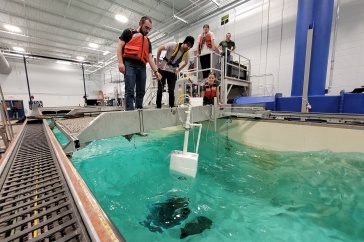It's the fires that give it away. The cluster of rolling green hills in Rochester, just visible from Route 125, are actually three giant piles of garbage—more than a million tons come to rest here each year. And down at the bottom of each hill, two candle flares burn steadily. The flames are fueled by methane, a byproduct of decomposing garbage—and a greenhouse gas. Waste Management Inc., the company that runs the landfill project, burns the gas before it hits the atmosphere where it can do damage.
But some forward thinkers at UNH have an even better idea. They want to transform the landfill gas into energy. According to Paul Chamberlin, assistant vice president for energy and campus development, piping methane from the landfill to the university could eventually provide up to 85 percent of UNH's energy needs.

PEDAL POWER: Oyster River Middle School
students, from left, Emily Healy, Leah Janelle and
Emma True find out how much energy is required
to light fluorescent vs. incandescent bulbs at an
exhibit about energy at the UNH Museum in
Dimond Library.
The project still faces several hurdles before it becomes a reality—like a $40 million price tag and the construction of a 12.5-mile pipeline. The USNH Board of Trustees has given conceptual approval to the project; final approval is pending. But the future looks promising, based on the success of other gas-to-energy initiatives: Waste Management is providing methane from other landfills across the country to Fortune 500 companies like Nestle, BMW and GM. In the long run, these companies save money—and do something good for the environment.
The idea that you no longer have to choose between the economy and the environment is the driving force behind many of the "greening" projects underway at UNH, according to Tom Kelly, director of UNH's Office of Sustainability. The university's new electric and steam-generating "co-gen" plant is perhaps the most dramatic proof of this theory. The state-of-the-art facility, which came online last summer, has dramatically reduced emissions of sulfur dioxide, nitrous oxides and carbon dioxide. The plant is also expected to save the university $30 to $40 million over the next 20 years, a welcome respite from the ever-rising cost—$12.5 million this year—of heat and electricity. Add the new pipeline to this equation, and UNH is likely to be largely energy independent in just a few years.
The co-gen plant and the pipeline project are just two chapters in what is emerging as a nationally recognized success story here at UNH. The university is already in the top 5 percent of energy-efficient campuses nationwide. "When EPA officials talk to energy managers at colleges and universities across New England, they point to UNH as an example of what can be done and how to do it," says Robert Varney '77, regional administrator of the EPA's New England office.
But technology and innovation alone do not make for energy-saving success. It takes community awareness, education and communication. In short, it takes people power—something that's been gaining momentum lately on campus. Discussions and activities related to energy are being integrated into the curriculum as the theme of this year's University Dialogue. Students study energy in depth in majors like environmental engineering, environmental education or environmental conservation. On the research side, scientists in chemical engineering and physics are exploring biodiesel and renewable energy systems.

This fall, UNH students issued their own challenge: to switch off, swap out, close up, unplug—and see which dorm could save the most compared to its own past use. Inspired by a "power down" initiative over the 2005 holidays, which saved an estimated $20,000, the Waste Watch Challenge was led by energy captains—one for each dorm—sporting T-shirts and pins to prove they were on the job and proud of it.
The winner of the challenge, Hubbard Hall, reduced its energy consumption by almost 30 percent and water usage by 8 percent, and won $300 for its dorm fund and a homemade trophy to show off. Then they used some of the money from the energy savings for a pizza party, T-shirts and environmental causes of their choosing. Overall, the contest saved $18,000 in energy and water costs; the students plan to repeat it in the spring. The challenge was designed to engage students in sustainability efforts, according to Sara Cleaves, associate director at the Office of Sustainability. Along with Matthew O'Keefe '97 at the Energy Office, Cleaves coordinates the UNH Energy Task Force, formed in 2005 to promote a campuswide effort to reduce energy costs and emissions at UNH.
The long-term goal among all these groups is to get the whole UNH community working together: thinking about saving money and saving the planet, thinking about their own lives and how they can make a difference. Their goal, in the end, is to build a sort of university Green Team—one that generates a new kind of "power to the people."
 ENERGY INDEPENDENCE: Seeking to reduce both expenditures and emissions, UNH is investigating importing methane gas from a local landfill and helping to build a mini-processor that can convert sunflower seeds to biodiesel. ENERGY INDEPENDENCE: Seeking to reduce both expenditures and emissions, UNH is investigating importing methane gas from a local landfill and helping to build a mini-processor that can convert sunflower seeds to biodiesel. |
"I do not understand how people cannot ride a bike on campus," says Lena Collins '07, heading out after one of her energy captain meetings. "We can live life without worrying about gas and parking. We can get anywhere here on a bike."
Other captains make their way on foot or hop on the campus shuttle. This is what transportation looks like on a "walking campus," which is precisely what UNH is striving to be. "The walking campus is a cornerstone goal of the master plan," says Steve Pesci '87, '92G, manager of special projects for Campus Planning. Walking, bike riding and bus riding are encouraged by consolidating larger lots on the edges of the core campus and providing a high-frequency shuttle service around campus.
The UNH bus system isn't successful just because it's convenient, though. It's also clean. Really clean. Six brand new compressed-natural-gas buses ferry students, faculty, staff and the public around campus. Purchased with federal air-quality funding, the sleek, futuristic vehicles are 25 percent more efficient and less polluting than buses running on gasoline or diesel fuel.
The balance of the Wildcat Transit fleet runs primarily on a blend of 80 percent petroleum diesel and 20 percent biodiesel, processed from biological sources like vegetable oil. The recently expanded fleet carries almost 1 million passengers a year, making it the largest transit system in the state.

Last summer, the university began converting its service vehicles (including construction and maintenance vehicles) to compressed natural gas, electric or the biodiesel blend. Every vehicle switched over means fewer heavy metals and less sulfur dioxide and carbon dioxide are being spewed into the air. Burning biodiesel also reduces cancer-causing particulates by as much as 82 percent. Much of the work has been funded with federal money designated for air quality improvement.
The new biofuel is so promising, in fact, that UNH is starting to work with local farmers who grow crops that have fuel potential. In the sunlit fields at the Kingman Research Farm in Madbury, N.H., local farmer Dorn Cox recently led UNH Extension Specialist Becky Grube and visitors from Vermont on an inspection of a planting of sunflowers. Gesturing to the nodding flowers, heavy with black seeds, Cox described his arrangement with UNH: he will harvest and refine the oil from the plants, reporting quality and quantity data that will be available to farmers and researchers everywhere.
Biodiesel will also be produced at UNH's Woodman Farm with a small-scale processor built with funding from the College of Life Sciences and Agriculture and the Office of Sustainability. The miniature patent-pending apparatus will convert waste vegetable oil from UNH's kitchens to biodiesel that can be used as a heating fuel or in off-road farm equipment.
Meanwhile, the vision of a walking campus has sparked other energy-saving changes at UNH—like the construction of a vehicle/pedestrian/bike tunnel under the railroad tracks on the south side of campus, to be built with $6.5 million in federal money. Next summer, bike lanes will be added along Main Street, too. Plans to rebuild the historic UNH Dairy Bar are also in the works, expanding the building to include a functioning station once again for Amtrak trains and buses. "It will be pretty messy and dusty next summer," Pesci notes, "but it's all part of a creating a more balanced transportation system and landscape-permitting people to move around using less energy and creating fewer emissions."
Nowhere on campus are the words "fewer emissions" more fitting than at the new UNH power plant, where natural gas (which may be replaced within a year by landfill gas) is the fuel for the co-gen process. Among the best of new efficiency technologies, this process involves only a single device, which generates both electrical power and heat.
At UNH, a gas-fired turbine (essentially a jet engine at work on the ground) has replaced the old steam boilers in the central heating plant and substantially reduced the amount of electricity purchased for the campus. Because they produce enormous amounts of waste heat, electric generators are considered relatively inefficient. In a co-gen system like the one at UNH, on the other hand, waste heat is captured in a vast duct arrangement and drawn off to produce steam in a boiler system. Most of the steam is used to produce hot water, which is then piped around campus.

From left, Liz Joseph '08 and Lena Collins '07
helped run a contest to reduce electricity
and water use in dorms.
When the pipeline project is finished, methane gas will flow into UNH's power plant at 2,500 cubic feet per minute (cfm), reaching a high of 4,000 cfm when the landfill reaches capacity. The supply is expected to last for at least 20 years. Once the project is underway, the greenhouse gas emissions attributable to UNH will be reduced by at least 57 percent, compared to 1990 levels. And the pipeline project has an added benefit, notes Chamberlin: more stable energy costs. "Costs have been rising an average of 18 percent annually over the last five years," he says. "And we experienced tremendous market unpredictability post-Katrina." Mostly, though, Chamberlin is proud of the university's ongoing commitment to be good stewards of the environment. "For me," he says, "that is the real win."
From modest quarters in a modular unit behind the Leavitt Center, Jim Dombrosk '95G and his crew keep tabs on 500 meters covering a host of energy districts on campus. "We are in the first phase of putting radio transmitters on those meters, so they will report their measurements directly to the computer, taking readings every half hour," explains Dombrosk, UNH's director of energy and utilities. "The very precise monitoring means adjustments can be made quickly—and more energy can be saved."
After 30 years of energy-saving innovations, Dombrosk has earned a reputation as UNH's energy guru. When he first arrived, for example, he was managing the new building control systems. Instead of allowing the electrically heated residence halls—Stoke, Williamson, Christensen—to come online all at once, forcing UNH to pay a high kilowatt-hour rate, Dombrosk wrote a program that brought the heating load in a staggered or rolling pattern, keeping residents warm but "shaving the peak" and reducing the rate.
Since then, Dombrosk has been a tireless champion of UNH's greening efforts, pursuing new technology, fuels and building designs; promoting policy, education and awareness. The tools of his trade? Variable speed drives, energy exchangers, "smart" breakers, movement sensors, specially designed ventilation and lots of specialized software—including computer monitor-control software that alone saves the institution $75,000 a year.
Today, many UNH buildings qualify for EPA's vaunted Energy Star rating. Last year, three UNH dorms—Congreve, Lord and McLaughlin—were the first dorms in the nation to receive an Energy Star rating after students in professor Ihab Farag's chemical engineering class, Energy and the Environment, took up the challenge of measuring how much energy the buildings use and how much pollution they generate. "It's critical to know how much you are using and where," says Dombrosk, who oversees an ongoing inventory for the entire university.
Another cost-saving scheme Dombrosk employs involves varying the amount of air that is moved, heated or cooled according to the time of day and the number of people using a particular building. "You can save so much with today's energy costs," he says, "that it makes it possible to pay off the cost of putting in the technology pretty quickly."
The same thing goes for lighting. When engineering students haunt the labs and computer clusters of renovated Kingsbury Hall, working late into the night, sensors and smart breakers follow them, clicking lights on and off to provide light only where it's needed. Control systems like this, combined with other energy-efficient building measures, save UNH $4 million annually.
Back in the residence halls, the energy captains continue their crusade to make every student on campus aware of the work of Jim Dombrosk and his team, to help students understand the importance of these efforts, and, ultimately, to join the larger UNH energy-saving team.
"I've been going door-to-door and there has been a great response," says energy captain Lena Collins, who was nervous at first about facing upperclassmen. "They are kind of set in their ways," she says, "and energy is really a personal thing—taking showers and blow drying your hair. We're pushing people out of their comfort zone."
"That's why they call it a challenge," says Liz Joseph '08, who has been cultivating awareness through a variety of tactics: signs in the hall with Did you know...? facts followed by What can you do...? suggestions, and leading by example. "Everything from riding my bike, to what purchases I make, to how long I shower, to engaging in conversation about why I make these choices."
In a semester abroad in New Zealand last spring, Collins encountered sustainable living. "They encouraged us to take fewer showers, hang our clothes on the line and cut back on computer time. They really enforced energy consciousness. I've tried to keep those things in my life back here," she says. "You can turn off your computer—life will go on. And I don't blow dry my hair anymore at all."
Both Joseph and Collins see a growing awareness on campus. More and more people agree with the idea that what they do as individuals is important to the welfare of the whole community. And they give the university credit for creating this kind of awareness. "If each of us does our small share, as part of the collective whole," says Joseph, "then we will do great things."
Bill Burtis is the communications manager at Clean Air-Cool Planet in Portsmouth, N.H.





















































